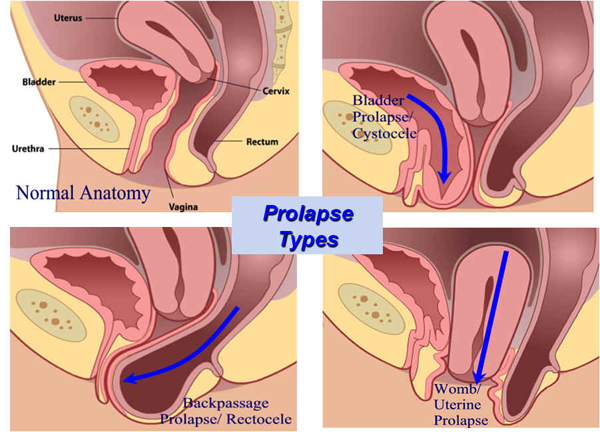Pelvic Organ Prolapse (POP), is defined as weakness of the muscles, ligaments and connective tissues of the vaginal wall, causing descent of the pelvic organs. This weakness can result in bulging of the urethra and bladder, cervix and uterus, small intestine or rectum into the vaginal wall.
Causes of prolapse are:
1) Childbirth
2) Weak pelvic floor muscles
3) Repetitive straining or bearing down
4) Heavy lifting
5) Chronic coughing
6) Family history of Prolapse
7) Hysterectomy
8) Decreased estrogen
9) Constipation
Signs and symptoms of POP are:
1) Feeling of something falling out of the vagina
3) Constipation
4) Painful intercourse
5) Groin pain
6) Heaviness, fullness or pressure in the vagina
7) Incomplete emptying of bladder or bowel
Types of Prolapse: *diagram below
Cystocele – (anterior vaginal prolapse) – When the bladder protrudes in the vaginal canal
Rectocele – (posterior vaginal prolapse) – When part of the rectum pushes into the back of the vaginal canal
Uterine – (apical/superior prolapse) – When the uterus descends into the vaginal wall. In those women who have had a hysterectomy, the top of the vagina can descend into the lower half.

Enterocele – When the small bowel protrudes into the front or back of the vaginal wall.
A recent article published in the British Journal of Obstetrics and Gynecology, informed the readers that 50% of women undergoing a routine gynecological internal assessment, had an identified prolapse. Pelvic organ prolapse often significantly impacts their functional daily activities.
Childbirth (parity) is a well established risk factor for the development of prolapse. According to current body evidence, the alteration in pelvic organ support, during pregnancy and birth, may increase a woman’s risk for POP to eight-fold after one vaginal delivery, and a twenty-fold increase after three vaginal deliveries, compared to women who have had cesarean sections.
During pregnancy, due to circulating pregnancy hormones and increased weight of the expanding uterus and fetus, the pelvic floor muscles often relax. Pelvic organ prolapse at 36-38 weeks of gestation, first trimester body mass index, newborn birth weight and smoking status almost are variable with affect on POP development. More research is needed regarding mechanisms leading to persistent and/or progressive pelvic organ prolapse after childbirth labor.
Women’s Health Physical Therapy can offer the following care for POP (pelvic organ prolapse):





Want to know your risk of pelvic organ prolapse, send us a message and mention this blog post and we will send you a free POP RISK FACTOR QUESTIONNAIRE.

